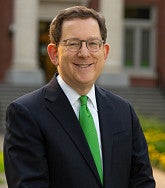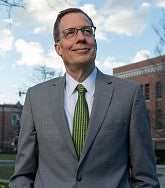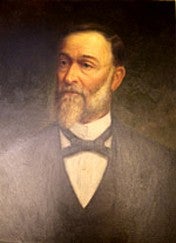
John Wesley Johnson
President 1876-1893
The first president of the University of Oregon did not learn his alphabet until he was ten. Nonetheless, he walked across the continent as a child in the 1850s, returned to the East Coast as a young man, graduated sixth out of 100 from Yale, and returned to Oregon where he worked as a teacher and administrator until selected in 1876 as first president of the UO. In addition to teaching Greek and Latin, his duties as president also included those of registrar, business officer, provost, dean of students, and secretary. In his seventeen years as president he urged Oregonians to overcome their suspicion of higher education and focused his energies on quality and essentials, building a solid base for the future.
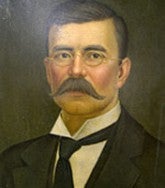
Charles Hiram Chapman
President 1893-1899
Involved at every level of decision-making at the university, President Chapman was able to make substantial changes in the curriculum, adding biology; civil, mining, and electrical engineering; business classes; physical training; and controversial electives. Though not always popular with townspeople, he traveled the state, gaining support from citizens for higher education. He was respected widely, but budget considerations often forced him to cut faculty salaries, making him less than popular on that front. Though this pressure finally brought about his resignation, his accomplishments, including a larger student body, a better-qualified faculty, an expanded library, and participation in intercollegiate athletics, moved the University of Oregon to the cusp of the twentieth century.
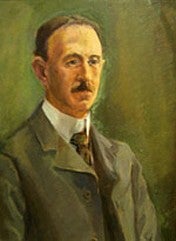
Frank Strong
President 1899-1902
As the university's first president in the twentieth century, Frank Strong worked to make the UO live up to his belief that a university should be a citizen of its state. Gaining approval from the regents to create departments with deans, he brought outstanding individuals to the faculty, devised a plan for accrediting high schools in the state and admitting their students to the university, and improved the library. In spite of disagreements with the regents over a teacher education program, which led to his resignation, he left the university in a better position to serve as an effective citizen of its state.
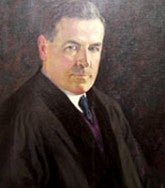
Prince Lucien Campbell
President 1902-1925
At the time of President Campbell's arrival at the UO, student enrollment stood at about 250 and an annual appropriation of $47,500 satisfied its fiscal needs. When he died in 1925, enrollment had grown to 3,000 students and the annual budget was $966,000. Leading with great personal charm and skills as an orator, Campbell focused his time and energy on building harmony between faculty members and students as well as on increasing the stature of the faculty. One of his key hires was Ellis F. Lawrence, who founded the School of Architecture and Allied Arts and radically changed the look of the campus through his design of dozens of university buildings. Campbell also used his considerable abilities of persuasion to gain legislative and popular support for increased state funding for the university. In his twenty-three years as president, Campbell made the UO the modern university it is today and did so with intelligence and grace.
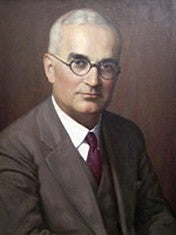
Arnold Bennett Hall
President 1926-1932
A nationally known political scientist from the Midwest, President Arnold Bennett Hall came to the UO promising increased emphasis on scholarship and research. Though funding for some of his projects passed the legislature, many proposals were vetoed or drastically reduced by the governor. Recognizing that tax dollars would continue to be hard to come by, President Hall turned to private gifts—endowments that would help ensure the quality of the university. In the midst of his attention to fundraising, he also led opposition to a proposal, finally defeated, that would have combined the UO and Oregon State College into one campus in Corvallis. The Arnold Bennett Hall Society, which recognizes donors who have made gifts to the university through planned giving, remains his legacy, along with the increased private giving he encouraged.
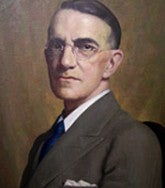
Clarence Valentine Boyer
President 1934-1938
With the nation in the midst of the Great Depression, President Boyer came into office facing plummeting enrollments and budgets, along with elimination of many faculty positions. Just before he took office, in an effort to save money and eliminate duplication, all science classes were moved to Oregon State College and all social sciences moved to the UO. Opposed to this and wanting immediate return of the science classes to campus, Boyer found himself at odds with the university's Advisory Council, which favored a slower process. In spite of these struggles, Boyer was able to gain funding for three major building projects—the library, the men's physical education building, and the infirmary. Boyer resigned for health reasons in 1938, but stayed on at the UO as dean of arts and letters, chairman of the Department of English, and professor until 1947.

Donald M. Erb
President 1938-1943
After several UO presidents who served relatively short terms, Donald Erb was selected at age thirty-seven, in part because it was believed he would give the university a president with a long tenure. With the national economy improving somewhat, Erb used his considerable patience and powers of persuasion to gain the return of science classes to the UO. World War II saw students and faculty members depart for military service, but Erb foresaw their return and worked to prepare the university for an influx of ex-GIs when the war ended. In line with this, he also successfully lobbied the state board for funds for a student union building, an idea that had originated with former President Campbell in the 1920s. Erb, however, did not live to see this project completed, as he died of pneumonia in 1943 at age forty-three. The completed student union was named after Erb and dedicated as a memorial to him and to those from the university who served and died in World War II.
Orlando John Hollis
Interim President 1944-1945
Dean of the Law School
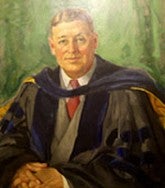
Harry K. Newburn
President 1945-1953
When Harry K. Newburn became the eighth UO president, he faced a rapidly growing enrollment on an under-staffed and under-built campus. Student housing was inadequate to meet the 81 percent enrollment increase from 1945 to 1946, and long-time faculty members were reaching retirement age. Convincing the legislature to allow salary increases, he enabled the UO to compete for and attract more highly qualified professors. The classroom, office, and housing shortages were met with a variety of responses, some temporary, such as Quonset huts used as classrooms, and others more permanent, such as the building of Emerald Hall and the establishment of single and married students housing. During President Newburn's tenure, the number of graduate degrees earned also increased dramatically.
Victor Pierpont Morris
Interim President 1953-1954
Dean of the School of Business Administration
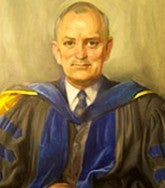
O. Meredith Wilson
President 1954-1960
To lead a university of distinction was the primary goal of O. Meredith Wilson when he became the UO's ninth president in 1954. Working to increase the funding that would attract outstanding faculty members and students, he believed the UO was at a turning point of accepting the status quo or becoming a major university. To help achieve his goals for the university he worked hard to create a graduate school of high standing and to attract faculty members, deans, and department heads who had proven ability or high potential as scholars. Throughout his presidency he combined an unusual ability to communicate with faculty members in their specialties with a solid belief that a university must offer a fertile ground for free exchange of all ideas. His efforts lay the groundwork for the UO's election in 1969 into the prestigious Association of American Universities and moved it well on its way to becoming a distinguished university.
William C. Jones
Interim President 1960-61
Dean of Administration
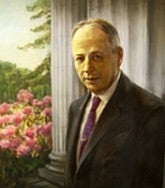
Arthur S. Flemming
President 1961-1968
As a former Secretary of Health, Education, and Welfare in the latter part of the Eisenhower administration, Arthur Flemming brought to the UO presidency his vast knowledge of government and the ability to gain federal grants for the university. University enrollment, faculty size, and curriculum were expanded, with the addition of the School of Librarianship and the School of Community Service and Public Affairs. Controversy filled his tenure, as he defended the right of U.S. Communist Party secretary Gus Hall to speak on campus and also maintained the right of the literary magazine Northwest Review to publish so-called "dirty poems." In the end, the gap between the more conservative voice of Oregonians who disapproved of his laissez-faire administrative attitude and young students who saw him as the voice of forward thinking moved him to resign and accept an offer of the presidency of Macalester College.
Charles E. Johnson
Interim President 1968-69
Dean of the College of Liberal Arts
N. Ray Hawk
Interim President 1969
Dean of Administration
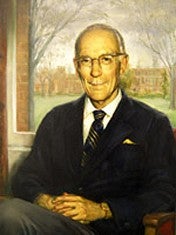
Robert D. Clark
President 1969-1975
Robert D. Clark's presidency reflected his academic beginnings at the UO as an assistant professor of speech. Understanding that half of communication is listening, he maintained an open door—and an open mind—to the student-initiated questions and challenges of the late '60s and early '70s. However, as dissent on campus threatened to spiral into anarchy—bombings, fires, and large-scale demonstrations—he also made it clear that he would not let the university be destroyed by protests. As university enrollment dropped in the early '70s and federal funds dried up, President Clark was forced to make hard decisions on program cuts. Establishing an advisory group of administrators, faculty members, and students, he sought policy that was as fair as possible and that left the university still in a strong academic position. Through his six years as president, women and minorities made long overdue gains, and the Honors College that he had established as an administrator in the 1950s was strengthened and renamed the Robert Donald Clark Honors College.
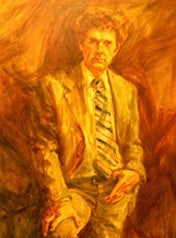
William Beaty Boyd
President 1975-1980
William Boyd arrived on campus for his inauguration as the UO began celebrations of its centennial. The turmoil and tumult of the previous few years were replaced by a time of fewer confrontations and more effort at change from within—an approach President Boyd fully backed. Reorganizing the central administration, Boyd created a stronger provost position to deal with day-by-day business (held by his successor Paul Olum), allowing the president to focus on broader issues, such as minority programs and budget concerns. Boyd strongly voiced his belief in the value of a liberal education that could enable students to "prevail in any economy" and "live richer and more contributive lives on the job and elsewhere." Both charismatic and private, he ended his final commencement speech with the Kurt Vonnegut quote, "Damn it, baby, you've got to be kind."
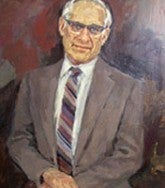
Paul Olum
President 1980-1989
Leading by example, rather than mere management style, President Olum felt strongly that the growing national stature of the University of Oregon was well deserved. At one time a scientist on the Manhattan Project that developed America's first atomic bomb, Olum, even as university president, took strong stands for nuclear disarmament, against apartheid, and for increased state funding for higher education. Though some criticized his activist role, most regarded him with respect for his moral stands and his ability to keep an excellent faculty at the university and attract students who felt they were coming to one of the best public universities in the nation. Tremendous growth took place during his tenure, including the establishment of twenty new research institutes and academic programs, and construction that included a $34.6 million science complex and a $27 million remodeling of the library. Though he was "retired" by the State Board of Higher Education, he remained loved and respected by his peers and students.
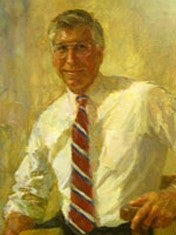
Myles Brand
President 1989-1994
In his five years as president, Myles Brand piloted the university through some of its toughest financial times, making cuts that eliminated programs and jobs. Driven by tax-cutting measures passed by voters, the cuts forced the university to adopt a more entrepreneurial approach to funding, with President Brand encouraging the aggressive recruitment of out-of-state students. He also initiated a campus-wide planning process that resulted in greater emphasis on undergraduate education, an international curriculum, graduate student support, campus infrastructure, and externally funded research. Brand and the faculty also oversaw a restructuring of many courses from three to four credits, as well as an academic productivity plan. President Brand's final effort was the groundbreaking "Oregon Campaign," which became the most successful private fundraising campaign in Oregon history, ultimately bringing a total of $255.3 million from private donors to the UO.
Dave Frohnmayer
Interim President May 11, 1994-June 30, 1994
Dean and Professor, School of Law
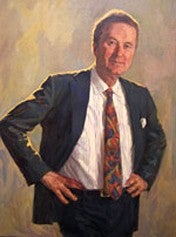
Dave Frohnmayer
President 1994-2009
No University of Oregon president since Prince Lucien Campbell served so long nor, many would say, was so admired—even loved—during his tenure as Dave Frohnmayer. In his investiture speech, President Frohnmayer spoke to the strengths of the university, saying, "We do not need a different university. But we must constantly dedicate ourselves to the development of a better one." The first Oregon native to become president of the UO, Frohnmayer came to this office having served several terms in the Oregon legislature, three terms as state attorney general, as legal adviser to the UO president, and as dean of the UO law school. He advanced that goal of developing a better university through an emphasis on new approaches to more effective teaching and through fundraising efforts to endow teaching positions, establish more student scholarships, and create a number of new academic programs. He also led efforts to bring to campus a new law center, a new student recreation center and science facilities, and additions to the art museum, the business college, and Autzen Stadium. In all, he aimed "to transform lives through knowledge, each of us, every day."
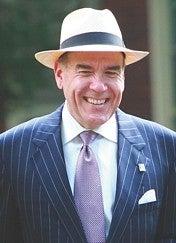
Richard W. Lariviere
President 2009-2011
Richard Lariviere transformed the policy debate about higher education in Oregon. The 16th president’s pursuit of excellence for the UO inspired a sense of optimism and aspiration to greatness that was shared by the faculty, students, alumni, and staff of the University. Lariviere demonstrated his commitment to excellence and the retention of faculty and staff by significantly raising their compensation. He oversaw the re-writing of the Constitution of the Senate enhancing the shared governance of the university. He received the greatest attention for advocating a “New Partnership” with the state of Oregon, through a combination of public policy, governance, and funding reforms. Lariviere renewed the University of Oregon’s commitment to its public mission to provide excellent opportunities for all Oregonians. The proposed New Partnership that embodied these aspirations and the community’s advocacy for these goals was not well received by the chancellor of the Oregon University System and the State Board of Higher Education. The resulting rifts culminated in the State Board’s decision to terminate Lariviere’s contract halfway through his third year, causing a firestorm of protest on campus and across the state. He left a legacy of renewed passion for high ideals and a solid foundation on which to fulfill them.
Robert Berdahl
Interim President Dec. 9, 2011-July 31, 2012
Presidential Advisor
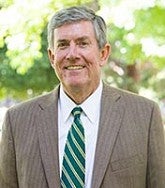
Michael Gottfredson
President 2012-2014
Although Michael Gottfredson’s tenure as president was short, he led the university through one of the most significant shifts in its history. A lifelong advocate for quality public higher education, he worked tirelessly to secure the passage of historic legislation that created institutional governing boards for the University of Oregon and the state’s other public universities, a shift he considered essential to preserving the UO’s standing among the nation’s premier public research universities. As president, he led the establishment of the university’s Task Force on Alcohol and Other Drug Use, the creation of key new positions including university ombudsperson and governmental liaison to Oregon’s federally recognized tribes, and the strengthening of the university’s academic freedom policy. Gottfredson is a widely respected criminologist who has remained active in his academic field throughout his administrative career. He resigned as president in 2014, shortly after the UO’s new board of trustees assumed governance of the institution, leaving as his legacy a new governance structure designed to support the university in a climate of reduced state support for higher education.
Scott Coltrane
Interim President Aug. 7, 2014-July 1, 2015
Provost and Senior Vice President
Michael H. Schill
President 2015-2022
Michael H. Schill’s tenure as president of the University of Oregon began in 2015. At the start of his presidency, Schill outlined four priorities to advance the UO’s mission: enhance academic and research excellence, support student access and success, provide an outstanding experience, and improve inclusion and diversity. Under his leadership, the university has reached new heights with the opening of the Phil and Penny Knight Campus for Accelerating Scientific Impact in 2020, an increase in UO’s four-year graduation rate by 10 percentage points—a year ahead of the goal—in 2019, and the launch of the Ballmer Institute for Children’s Behavioral Health in 2022. Schill led the extension and historic close of the university’s fundraising campaign in 2021 which exceeded its goal with $3.2 billion raised. His leadership has provided stability and direction throughout his time as president, from cementing the institutional governance structure to navigating the COVID-19 pandemic which disrupted every aspect of university operations. Schill left the university in 2022 to become the 17th president of Northwestern University in Illinois.
Patrick Phillips
Interim President Aug. 20, 2022-March 13, 2023
Provost and Senior Vice President, Biology Professor
Jamie Moffitt
Interim President March 14, 2023-June 30, 2023
Senior Vice President for Finance and Administration, Chief Financial Officer
John Karl Scholz
President 2023-present
Karl Scholz joined the University of Oregon as its 19th president after serving as the University of Wisconsin-Madison’s provost since August of 2019. Scholz is a distinguished economist and professor whose economics expertise is in household savings, low-wage labor markets, financial barriers to higher education, and bankruptcy laws. He previously served for six years as the dean of UW–Madison’s College of Letters & Science and as director of the university’s Institute for Research on Poverty. He served in two presidential administrations, working in both the U.S. Treasury Department and the Council of Economic Advisors. Scholz graduated from Carleton College in Northfield, Minnesota, and earned his doctorate from Stanford University. Scholz is married to Melissa Scholz, an attorney focused on non-profit law. They have three daughters, one of whom is currently a PhD student at the University of Oregon.

